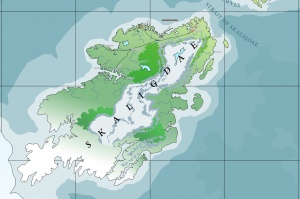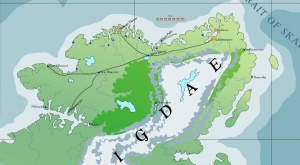Skaligdæ
Skaligdæ is an immense island north of Antarctica and south of New Pytharnia (in Bahuna), in the southern hemisphere. The island has mild summers and cold winters. Most colonists are from the Pallathantic, especially Thrace, with a large Lucacian minority. The largest inhabited cities are on the coast which affords a more moderate climate and more direct access to windships and sky vessels from abroad.
Wild, free-roving clans compose Skaligdæse orcs and this is perhaps the main reason they have not swept the organized, technologically-advanced colonists off of Skaligdæ.
Southern Skaligdae is a vast tractless forest with snow-capped mountains where ancient dragon kindreds persist even in this modern age. Enormous mammalian creatures left over from a previous epoch roam the cold reaches of southern Skaligdae, similar to mastodons, sabre-toothed tigers, titanotheres, and so forth.
Skaligdæse Colonists
Although the Aurician Empire governs Skaligdæ, most of the colonists are not from Lucacia. There's no single majority, but the largest group of humans compared to any other single group are the Thracians who homesteaded the first colonies shortly after Thracian explorers discovered the island. The next largest group are the Pytharnians, Asdbardians, and Dúrandworese. Lucacians actually only make up a smaller minority. The effective language of the colonists varies from household to household, but in public places, the Thracian Language prevails.
Cities and Settlements of Skaligdæ
| Settlement Name | Population in 2745 | Remark |
|---|---|---|
| Amasga Tharsa | 13,500 | Third Level Political Authority |
| Galdimasçino | 79,300 | Colonial Capital, largest city |
| Helivoro | 63,800 | Third Level Political Authority, second largest city |
| Karaço | ||
| Moksojani | 780 | Largest settlement of the Anyamuna Giants |
| Monastery of Saint Olmima Olima of Perpetual Knowledge | 350 | |
| Naza Pulzo | ||
| New Mageton | ||
| Nikriasiti | ||
| Pamertha | 28,500 | |
| Saint Idhonyol (city) | 5,200 | |
| Saint Ithiraz' (town) | 2,300 | |
| Stalkastinozzo | named after House Stalcast | |
| Tajusinçozzo | ||
| name |
Anyamuna Giants
The great isle of Skaligdae lies in the southern hemisphere. The northernmost end is populated by colonists from Aurice, Corundy, and other Pallathantic Nations. Originally, several Pallathantic nations maintained colonies here, notably Ducal Bryndyd and Aurice, but due to a settlement as part of a peace treaty, Aurice gained the entire area, in return for her recognition of Bryndyd’s rule of New Pytharnia. [Skaligdaese War: 2576 to 2586]
The native population of northern Skaligdae are indigenous giant tribes, the Anyamuna. The Anyamuna are about 11 to 12 feet tall, have white or yellow white hair, bluish coloring, and green, blue, or opalescent eyes. They are not practitioners of Chaos magic and magic in general is foreign to them. Anyamuna tribes nominally acknowledge the overlordship of the Aurician Republic. A Gafsapi priestess rules over each tribe and her husbands serve as ministers and ‘generals’ for that tribe. The Anyamuna worship the forces of nature and the most powerful of their deceased ancestors whom they believe dwell in a spiritual counterpart to nature.
Aurician Rule
The Aurician Senate today appoints the Vice Lord-Governor of Skaligdæ. The island enjoys nearly complete freedom in internal matters but must defer to the Aurician governor in all foreign matters. Additionally, the Aurician Empire also claims all mineral rights on the island and has prepared charters for select corpora mercia to secure such resources. The Over-provincial Assembly consists of the representatives of landholders. As Skaligdæ does not have a long history, there are very few native aristocrats. There are several movements to separate from the Aurician Empire. However, Aurice's willingness to give the colonists virtually complete freedom in their internal affairs, the lack of any tribute to pay to Aurice, and subsidies for defending the colonists have ensured that talk of secession has remained talk only. Aurice is very direct about its control of mineral rights, but provides modern military equipment to the colonists to defend themselves from the orcs and the Anyamuna Giants. The extensive subsidies provided by the home government for protection and development are one of the main reasons the colony has not openly rebelled and sought independence.
Technological Development
Skaligdæ is rustic to most observers from the Pallathantic. However, modern military equipment and methods have ensured the safety of the colonists from the island's indigenous orcs. There is single dragonrail line that joins cities of the coast and the largest city of the near interior. Titancraft industry is basic and consists largely of maintenance and repairs. There are no major titancraft manufacturing concerns in the colony.
Chronology of Skaligdæ
- Pirrhaig Bragdathauch, Pytharnian lord who led expedition to Skaligdæ under Thracian flag in late 2400's
- Tuvarigrain Kadispällis, Thracian Vice-ducal Governor of Skaligdæ during the Aurician Revolution (2627 to 2634)
History of Colonial Rule in Skaligdæ
Thracian Discovery of Skaligdæ
Thracian captain Midiankumir Gandas led an expedition of nine skycraft over the years 2451 to 2479 which discovered the island in 2468, claiming the land in the name of the King of Thrace. Orcs were discovered and slain in due measure to make room for coastal settlements. Over the years 2487 to 2493, Lord Bragdathauch, a Pytharnian explorer, made a well-funded expedition to the great island in behalf of Thrace.[1]
Early Thracian Colonization of Skaligdæ
In the following one hundred years, Thracian colonists and other subjects of the Kalikán trickled into the northernmost tip of the island, bringing gontha, skycraft, and other crafts to the land. Only a few hardy colonists and political exiles came to the remote land and more Pallathantic people who left their homelands preferred New Pytharnia and other colonies in Orrhymby and Bahuna. Intrepid explorers penetrated the interior of the land which is a subarctic climate. Some returned with accounts of a mountain wasteland covered with pine trees or tundra. Most did not return and were assumed slain by orcs or to have succumbed to the harsh climate. The colony maintained ties with its fatherland through annual visits, but the Thracian Viceroy had nearly complete control of the island and ruled with an iron fist, reminding the colonists of the continual threat of orcish invasion. The vast distance to the Pallathantic made for little chance of complaint to the King of Thrace. Many early colonists came from a similar climate in the Jaggudorns. But unlike the Jaggudorns, Skaligdæ offered land for settlement and herding. Only the orcs stood in the way.[2]
Skaligdæ during and after the Great Sky War
The Great Sky War brought the colony into the attention of Pallathantic rulers. Before the signatories of the Treaty of Tauhad (2576) could gather in the Ithrads, Aurician agents sped to the southern hemisphere and led a revolution against the Thracian Viceroy, then claimed the island in the name of the new Grand Duchy of Aurice. Similar agents were sent to New Pytharnia, but could not secure the island. Later, news of the Treaty of Tauhad (2576) came to the Thracian Viceroy. Official envoys of the treaty signatories were sent to all the colonial holdings. The Treaty required that Thrace be stripped of all her colonial holdings and their independence ensured. The treaty did not use the term 'sovereign' and this left matters uncertain. Disagreement over the rule of both Skaligdæ and New Pytharnia erupted into conflict between partisans of Aurice and Asbardy in the Skaligdæse War, 2576 to 2586. Aurice retained rule of Skaligdæ but relinquished all claims to New Pytharnia which came under the rule of the Archduchy of Asbardy, in accordance with the Treaty of Yophénthë (2587).
Trooskan War
The Trooskan War, 2614 to 2632, arose between Asbardy and Aurice, as a result of the colonial ambitions of Aurice to conquer New Pytharnia. Despite superior titancraft technology, Aurice was unable to defeat Asbardy. The local dragonmount militia were especially effective in the dense woodlands of New Pytharnia[3]. The Treaty of Yophénthë (2632) brought about a formal end to the conflict without any territorial gains for Aurice.
Bijälian Rule, 2574 to 2626
During the rule of House Bijäl, Skaligdæ became an over-province administered by a vice-ducal governor appointed by the Grand Duke of Aurice. As the colony had been originally kept under the strong grip of the Thracian Governor, the new vice-ducal governor was a breath of fresh air that brought Aurician rule into favor with the colonials. Bijälian rule also saw the introduction of titancrafters and the search for panox in the earth.
Republican Rule, 2627 to Present
![]() The Aurician Revolution, 2627, brought uncertainty to the colonists. The Vice-ducal Governor, Tuvarigrain Kadispällis, appointed by Rhungast Bijäl, feared he would be removed from his post and made an effort to discover and remove all persons of influence with republican sympathies, hoping that the Bijälians would win the day. When news arrived in 2635 that confirmed the defeat of the Bijälians, Rhungast took a group of loyalists and fled into the hinterland of Skaligdæ. By 2636, the newly selected acting Vice Lord-Governor of Skaligdæ had been installed and the colonial capital renamed to Galdimasçino. The Noble Senate sent a legation to Skaligdæ to offer clemency and the office of Vice Lord-Governor to Kadispällis who finally accepted it.
The Aurician Revolution, 2627, brought uncertainty to the colonists. The Vice-ducal Governor, Tuvarigrain Kadispällis, appointed by Rhungast Bijäl, feared he would be removed from his post and made an effort to discover and remove all persons of influence with republican sympathies, hoping that the Bijälians would win the day. When news arrived in 2635 that confirmed the defeat of the Bijälians, Rhungast took a group of loyalists and fled into the hinterland of Skaligdæ. By 2636, the newly selected acting Vice Lord-Governor of Skaligdæ had been installed and the colonial capital renamed to Galdimasçino. The Noble Senate sent a legation to Skaligdæ to offer clemency and the office of Vice Lord-Governor to Kadispällis who finally accepted it.
Independence Faction
Despite the republic's continued efforts to thwart independence, there is a small but unfailing independence faction. The republican government of Aurice has not officially outlawed the group. Rumors are that the Aurician government uses bribes and sometimes 'accidental deaths' to deal with the independence faction. Some senators have advanced the idea of home-rule for the colony on the highest level.
Sources
See Also
| This article is a stub. It requires further development by the creator. |


